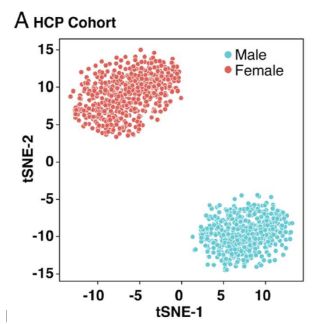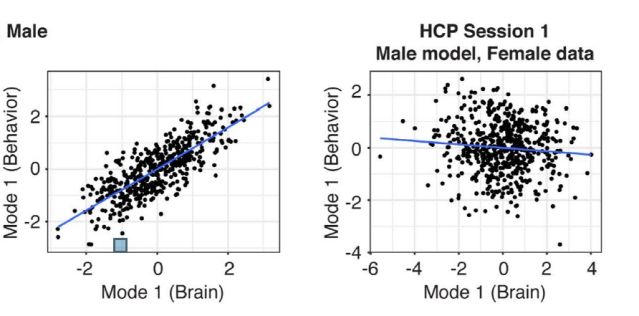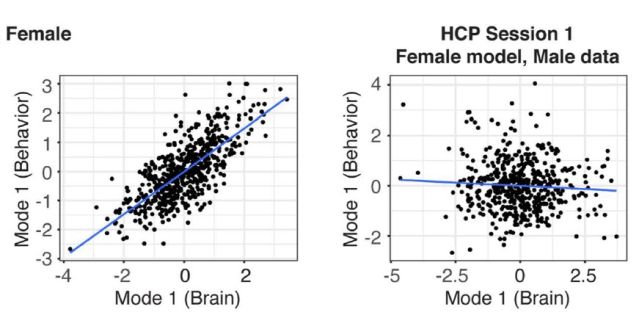Gender
AI Finds Astonishing Male/Female Differences in Human Brain
A new study shows huge differences, with no overlap between women and men.
Posted May 24, 2024 Reviewed by Tyler Woods
Key points
- A new study from Stanford shows remarkable differences between female and male brains.
- The researchers found no overlap between male and female, and rejected the idea of a "continuum."
- Male-pattern brain connectivity predicted male cognitive function but not female cognitive function.
- Female-pattern brain connectivity predicted female cognitive function but not male cognitive function.
Are male brains really that different from female brains? Does it matter? Why should anybody care?
More than 100 years ago, a German neurologist named Paul Julius Möbius published a book titled Über den physiologischen Schwachsinn des Weibes, “Regarding the physiological weakmindedness of women.” Möbius noted that women's brains are smaller than the brains of men, even after adjusting for differences in height. He concluded that women are “physiologically weak-minded.” In making that claim, Möbius was continuing a tradition in Western thought that we can trace back to Aristotle, namely: women and men are different. That means men are better.
The misogynistic arguments of men from Aristotle to Möbius have made many modern researchers leery of claims regarding female/male differences in the brain. Researchers have long since established that there are, in fact, no differences in average intelligence between men and women. But investigators have consistently found that women are more likely than men to experience anxiety and depression. Conversely, men are more likely than women to have autism, attention-deficit disorder, and schizophrenia. Are these male/female differences merely social constructs? Or might these robust differences in psychopathology reflect, at least in part, some underlying difference in neuroanatomy or neural connectivity?
A recent review of MRI studies of female and male brains concluded that “MRI-based studies exploring differences between male and female brains revealed mostly inconsistent and inconclusive findings.” Others have argued that while there might be differences, on average, between male and female brains, the differences are on a continuum, with lots of overlap.
But researchers at Stanford recently used artificial-intelligence methods to examine brain activity in roughly 1,500 young adults 20 to 35 years of age. Neuroscientists have known for many years that every human brain is characterized by a “fingerprint” of brain activity at rest, unique to that individual. The Stanford neuroscientists used big-data artificial intelligence techniques to determine the fingerprint of every one of those 1,500 young adults and then compared females with males. Did females differ from males? Was there overlap? The results were astonishing.

As you can see, there wasn’t a continuum: the female fingerprints of brain activity were quite different from the male fingerprints of resting brain activity, with no overlap. These findings strongly suggest that what’s going on in a woman’s brain at rest is significantly different from what’s going on in a man’s brain at rest.
Just as remarkably, the Stanford team mapped fMRI patterns of connectivity onto cognitive functions such as intelligence. They found particular patterns of connectivity within male brains that accurately predicted cognitive functions such as intelligence. However, that male model had no predictive power for cognitive functions in women.
Conversely, they found particular patterns of connectivity within female brains that accurately predicted cognitive functions such as intelligence among women. However, that female model had no predictive power for cognitive functions in men.
These findings strongly suggest that the determinants of cognitive functions in male brains are profoundly different from the determinants of cognitive functions in female brains.

I have to admit that I was really surprised by these results. I have been writing about these topics for more than 20 years. In the first edition of my book Why Gender Matters, published by Doubleday in 2005, I devoted a chapter to kids who are psychologically “gender-atypical.” I suggested that these kids are somewhere in between male and female. But the Stanford study provides little support for that claim. I am hopeful that the researchers will do follow-up studies specifically looking at individuals who are gender-nonconforming, gender-atypical, and who have gender dysphoria, to see whether and how those characteristics influence these findings.

The researchers are well aware of the implications of their findings. They know all about the previous studies suggesting small effect sizes, lots of overlap, and a continuum of male/female differences. They conclude that the failure of previous work to demonstrate these huge effects is due to the "weaker algorithms" employed in earlier research. They conclude: "Our results provide the most compelling and generalizable evidence to date, refuting this continuum hypothesis and firmly demonstrating sex differences in the functional organization of the human brain."
There has been very little coverage of this report in the mainstream media. You will find no mention of this study in The New York Times, the Wall Street Journal, or National Public Radio. I suspect that’s because most mainstream media are cautious of anything having to do with brain-based differences between women and men. Many of us are understandably wary that any claim of difference will lead to claims regarding ability. If men’s brains are different from women’s brains, doesn’t that imply that men will be better at some things and women will be better at other things? Especially when there is no overlap in the findings?
But “different” doesn’t necessarily imply “better.” As I stressed in the second edition of my book Why Gender Matters, apples and oranges are different. That doesn’t mean apples are better than oranges. Men and women are turning out to be different, more different than we may have imagined. That doesn’t mean that women are better than men, or vice versa. But it does suggest that if we ignore the differences, we may disadvantage both women and men.
References
Ryali, S., Zhang, Y., de los Angeles, C., Supekar, K., & Menon, V. (2024). Deep learning models reveal replicable, generalizable and behaviorally relevant sex differences in human functional brain organization. Proceedings of the National Academy of Sciences, volume 121, number 9, https://doi.org/10.1073/pnas.2310012121.




